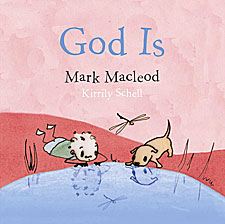 It's wonderful to have a picture book to review. For one thing, it doesn't take so long to read! Also, I am usually sure I will be able to understand it. However, that doesn't mean it isn't deep! Mark Macleod, prolific children's author, has produced a primer on God for primary school-aged children called God is….
It's wonderful to have a picture book to review. For one thing, it doesn't take so long to read! Also, I am usually sure I will be able to understand it. However, that doesn't mean it isn't deep! Mark Macleod, prolific children's author, has produced a primer on God for primary school-aged children called God is….
It would be easy to criticise Macleod for what is missing in this book: such as a clear definition of who this God is, for the absence of Jesus, for the lack of reference to Scripture… He has in fact deliberately chosen to be vague about the divine presence, describing it as energy or light or spirit in the review notes.
Instead, I would like to focus on the positives of the book. Firstly, it is significant that he has chosen to name the divine as "God" in the text. In fact his motivation is very interesting. It was in response to his adult children complaining to him about the emptiness of their lives. They had thought career or relationships or possessions would bring happiness. Macleod realised he had failed to teach them about spirituality.
So he decided to write an introductory book for children, an exploration of spirituality. He seamlessly blends intangible and tangible, to make the eternal able to be sensed. For example:
God is
in the music of the rain
at night on the tin roof
and the dance of a fire
and the stretch of a heart.
And more.
Each page ends with "And more", pointing to the fact that it is impossible to fully comprehend God.
As well as positive images, there are encounters with disappointment described: falls, and weeds, and lost love, and things that flit away.
In addition there is a movement away from the preoccupation with self found in many children's books: there is friendship, and looking for those you might have overlooked, and sharing the last best mouthful.
In the end God is portrayed as one who cares, who loves, who is the source of security, who is extravagant with his beauty, who is ever-present, who is all-powerful, and who wants us to enjoy his beautiful creation in all of its exquisite detail.
As I was pondering this review, a friend came along, who just happened to be a primary school teacher. She read the book and exclaimed at its "beautiful and powerful language". Then she shared her own disappointment at the broken dreams of life. The book had helped to open up an unexpected conversation about God and life and purpose and broken promises.
Another friend pointed out that is was Jesus who said we should come to him with faith like a child. Such a book then gives us the clues to the Gospel: a trusting acceptance of our Creator, and an implied response of gratitude.
In various interviews Macleod has spoken about his Presbyterian roots and his sense of God as someone who was stern and serious, waiting with a big book ready to write down all his misdeeds. Macleod ran away from that God, but faced his own crisis as an adult: the sense of "is there anything else?" and he ended up embracing Quaker faith. This book is in harmony with Quaker beliefs of the presence of God in each person, the need to become more aware of God's presence, and that God is experienced in community. In the illustrations that accompany the text the little boy is never alone.
Macleod is also completing the ABC Book of Christmas, a retelling of the nativity from Matthew and Luke, with illustrations by Australia's favourite children's artists, who have each chosen their favourite nativity scene.
While this book is not a replacement for children's Bibles, it could be a helpful step to a conversation with a child about daily encounters with God, with an increasing awareness of God's presence and care, and with the sorts of values that God's Spirit empowers.
It won't answer the question: "Who made God" but it may well distract them for a while!
















